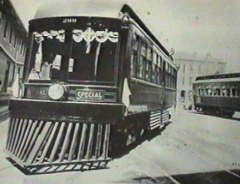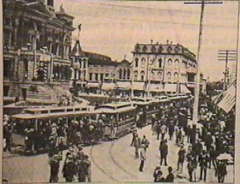
|
|
From: City of Anderson Illustrated (very early 1900's)by John O. Hardesty Cities--Anderson, Alexandria, Elwood, Gas City, Marion and Muncie. Incorporated towns--Fairmount, Fortville, Ingalls, Jonesboro, Middletown, Orestes, Pendleton and Summitville. Unincorporated towns--Alfonte, Chesterfield, Dundee, Lawrence, Linwood, McCordsville, Oaklandon and Yorktown. A department for handling small freight and express matter has been established. It would be more properly called a light express and package business, the handling of general or heavy frieght not being attempted. Provision is made in all passenger cars for baggage and parcels. GENERAL OFFICERS: Philip Mater, President, Marion James A VanOsdol, 1st VP, Anderson Frank M. Riter, 2nd VP, Philadelphia Charles L. Henry, Secretary & GM, Anderson Geo. F. McCullough, Treasurer, Muncie William MacLean, Ass't. Secretary & Treasurer, Philadelphia Charles Berry, Superintendant, Anderson. BOARD OF DIRECTORS: We all remember the Anderson street car system of eight years ago, with its uncertain track, dinky cars and dinkier mules, when the citizen of Hazelwood (an addition on the near west side of Anderson--webmaster), when leaving the public square, was uncertain he would reach his destination whole-limbed or not. Not infrequently derailed cars had to be jack-screwed out of the mud, while passengers stood about watching the operation. Those were the gallus days in street car transportation, but they are only a memory now. Hon. Charles L. Henry, prosecuting the practice of his profession, and engaging in politics preliminary to an election to congress, rightly concluded that this town was showing energy and enterprise enought to rapidly become a great city, and that the jerkwater street railway, with its franchises, could be made a dividend paying piece of property. He purchased the whole outfit and at once began the betterment of its physical condition. New rails were laid and miles of extension made, and electric power supplanted mule power at the very earliest date possible. Those were busy years for Mr. Henry, for during four years of the time this transition was going on he was serving faithfully and actively as a member of the American Congress. But the methodical way Mr. Henry does business enabled him to accomplish the work of half a dozen men of hap-hazzard business habits. Time will evidence that of the few who can be so called, Mr. Henry will be placed in the list of Anderson's benefactors, for, while the city sytem and the interurban will be sources of geat profit, what other man saw the future and its opportunities and had the courage to undertake what has grown to be so vast and costly an enterprise?"
|
Charles L. Henry

The Henry Residence
 1000 blk Jackson Street, Anderson
1000 blk Jackson Street, Anderson
Henry grave at East Maplewood Cemetery, Anderson, IN.
 photo taken 6-4-2000
photo taken 6-4-2000
(JJGrant collection)
Henry Family plot
 photo taken 6-4-2000
photo taken 6-4-2000
(JJGrant collection)
"Martha" #299

CITY STREET CAR LINES
In 1921, Birney type single truck safety cars replaced the old equipment in the three larger cities. The Elwood system was abandoned in 1924. The most important suburban operation of Union Traction was its Broad Ripple line, later to become the busy College Avenue line of the INDIANAPOLIS RAILWAYS. This line, ten miles in length, was opened in September 1894 and the first car was a single truck double-ender with closed vestibules and monitor roof. It was of course of wood construction. It was equipped with a whistle in addition to the usual gong, and sported a powerful arc headlight. The road was financed by a Dr. Light, whose home stood, until 1922, on "Light Free Gravel Pike", at a point now known as 63rd St. and College Ave. Mind you, at that time Indianapolis extended only as far north as about 16th Street. Everything beyond was open country and Broad Ripple was the nearest town. The cars originally started north via Illinois Street, later via Central Ave., and finally, after 1905, via College Ave. Double truck cars came into use on the Broad Ripple line about 1899. At this time it was known as Broad Ripple Traction Company, and was single track beyond the city limits. About 1907, Union Traction took over the property and renamed the park "White City". Both open and closed cars were assigned, and their dashers were painted white with "White City" lettered in black in an arch over the headlight. But a disastrous fire overtook the park and demolished most of the rolling stock, so, in 1909, ten new cars were acquired. As the city limits extended north the Broad Ripple Line became part of the Indianapolis Street Railway, in accordance with the terms of an agreement between the interurban and the local company. |
 White City car #182 at Anderson Shop.
White City car #182 at Anderson Shop.
An early streetcar

South Side of Public Square 1895
 Anderson, IN.
Anderson, IN.
IUT #274

Steel streetcar (IRR)

Meridian Street, Anderson, IN.
 Looking north from 14th St.
Looking north from 14th St.
Public Square
 Anderson, IN.
Anderson, IN.
Summitville

|
|
| |
|
|
||
| previous page |
|
next page |
|
|
||